
The State Flag of the Union of Soviet Socialist Republics, or simply the Soviet flag, was a red banner with two communist symbols displayed in the canton: a gold hammer and sickle topped off by a gold five-point star. The flag's design and symbolism are derived from several sources, but emerged during the Russian Revolution. It has also come to serve as the standard symbol representing communism as a whole, recognized as such in international circles, even after the dissolution of the Soviet Union in 1991.

The last Soviet Union (USSR)-era flag was adopted by the Russian SFSR in 1954 and used until 1991. The flag of the Russian SFSR was a defacement of the flag of the Soviet Union. The constitution stipulated:
The state flag of the Russian Soviet Federative Socialist Republic (SFSR) presents itself as a red, rectangular sheet with a light-blue stripe at the pole extending all the width [read height] which constitutes one eighth length of the flag.

The flag of the Kazakh Soviet Socialist Republic was adopted by the Kazakh government on 24 January 1953. The flag resembles the flag of the Soviet Union in defaced form with a 2/9 horizontal blue (azure) bar in the lower part of the flag and the hammer and sickle in the near centre.

The flag of the Kirghiz SSR was adopted by the Presidium of the Supreme Council of the Kirghiz SSR decreed by its Decree on 22 December 1952. The 1978 constitution of the Kirghiz SSR states that the ratio of the flag is 1:2 with the blue/white/blue stripes in the middle taking 1⁄3 of the flag height and the white stripes 1⁄20 of flag height. The red, blue and white colors were derived from the Pan-Slavic colours.

The flag of the Moldavian Soviet Socialist Republic was adopted on 31 January 1952. The flag has three horizontal bands of red, green (1/4) and red, with a hammer and sickle in the canton. As defined by the Presidium of the Supreme Soviet of the Moldavian Soviet Socialist Republic on the flag description:
The national flag of the Moldavian Soviet Socialist Republic consists of a panel of red color with a green stripe in the middle of the whole flag length, with the image on top of the red part of the flag from the flagpole golden hammer and sickle above a five-pointed red star framed by gold border. The ratio of the flag's width to its length is 1:2 with the bandwidth of green to the width of the flag 1:4

The flag of the Tajik Soviet Socialist Republic was the red Soviet flag with white and green stripes below the gold hammer and sickle, with the measures: 1/2 red, 1/5 white, 1/10 green, 1/5 red. The flag sported the Pan-Iranian colors of red, white and green, as a nod to the republic's Persian-descended culture. The flag was adopted on March 20, 1953 by decree of the Supreme Soviet of the Tajik SSR:
The national flag of the Tajik Soviet Socialist Republic is a panel consisting of four horizontal colored stripes: the upper band of red which is half the width of the flag; white stripe, making one fifth of the width of the flag; green stripes, is one-tenth the width of the flag, and the lower band of red color, is one-fifth the width of the flag. On top of the red band at the flagpole located gold hammer and sickle and above them is a five-pointed red star framed by a gold border. The ratio of the flag's width to its length is 1: 2.The fitting of the hammer and sickle into a square whose side wound 1/4 width of the flag. The sharp end of the sickle falls in the middle of the upper side of the square, handles the sickle and hammer rest on the bottom corners of the square. hammer with a handle length is 3/4 of the diagonal of a square. The five-pointed star in a circle fits 1/8 width of the flag relating to the upper side of the square. Distance vertical axis of the star, the hammer and sickle from the grapnel is equal to 1/4 of the flag's width. The distance from the top edge of the flag of the flag to the center of the star - 1/10 of the flag's width.

The flag of the Turkmen Soviet Socialist Republic was adopted by the Turkmen SSR on August 1, 1953. Although similar to the Flag of the Soviet Union, the layout is identical to the flag of the Kirghiz SSR with a ratio of 1:2. The two blue stripes between the red represents the rivers Amu Darya and Syr Darya, the red represents the "revolutionary struggle of the working masses", the hammer and sickle represents the peasants' and workers' union, and the red star is the symbol of the ruling Communist Party.

The first flag of the Ukrainian Soviet Socialist Republic (UkSSR) was adopted on 10 March 1919 to serve as the symbol of state of the Ukrainian SSR. Details of the official flag changed periodically before the collapse of the Soviet Union in 1991, but all had as their basis the communist red flag. According to the decree of the Presidium of Supreme Soviet of Ukrainian SSR on 21 November 1949, the blue in the bottom "symbolises the mightiness and beauty of the people, and the blue banner of Bohdan Khmelnytsky".
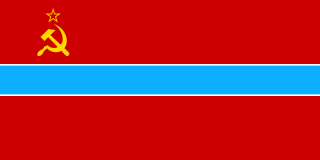
The flag of the Uzbek SSR was adopted by the Uzbek SSR on 29 August 1952. The red represents the "revolutionary struggle of the working masses", the hammer and sickle represents the peasants' and workers' union, and the red star is the symbol of the communist party. There is no official explanation for the symbolic meanings of other elements. However, in some material the white stripes represent cotton, the blue band represents Amu Darya and irrigation in general.

The Flag of Udmurtia is one of the official state symbols of Udmurtia. The proportion of width and length of the flag is 1:2. It is a rectangular three-color cloth consisting of vertical equal stripes of black, white and red with an eight-pointed red cross. The black colour in the flag is a symbol of the earth and stability, red means the sun and life and white means a space and moral purity. The designer of the flag of the Udmurt Republic was Yuri Lobanov. The appropriate law N26-РЗ "On the National Flag of the Udmurt Republic" appeared on April 30, 2002.
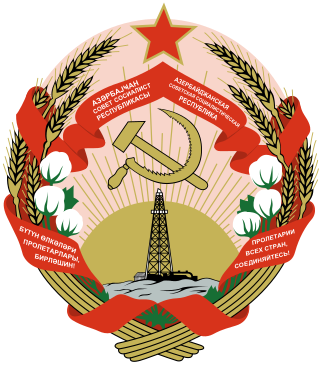
The national emblem of the Azerbaijan Soviet Socialist Republic was adopted in 1937 by the government of the Azerbaijan Soviet Socialist Republic. The style is based on the emblem of the Soviet Union.
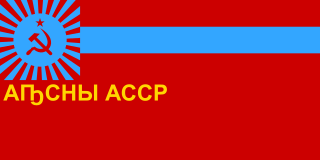
The flag of the Abkhaz Autonomous Soviet Socialist Republic was adopted in 1951 by the republic's government. Its primary visual features are identical to those of the flag of the Georgian Soviet Socialist Republic. A later version of the flag includes a gold inscription under the canton of the republic's name.

The State Anthem of the Azerbaijan SSR was the regional anthem of Azerbaijan when it was part of the former Soviet Union. It was created in 1944 and was used from 1945 to 1992.

The State Emblem of the Soviet Union was adopted in 1923 and was used until the dissolution of the Soviet Union in 1991. Although it technically is an emblem rather than a coat of arms, since it does not follow traditional heraldic rules, in Russian it is called герб, the word used for a traditional coat of arms.
The parade of sovereignties was a series of declarations of sovereignty of various degrees by the Soviet republics and the autonomouses in the Soviet Union from 1988 to 1991. The declarations stated the priority of the constituent republic power in its territory over the central power, which led to the War of Laws between the centre and the republics. The process followed the loosened power grip of the Communist Party of the Soviet Union as a result of demokratizatsiya and perestroika policies under Mikhail Gorbachev. Despite the efforts of Gorbachev to preserve the union under a new treaty in the form of the Union of Sovereign States, many constituents soon declared their full independence. The process resulted in the dissolution of the Soviet Union.
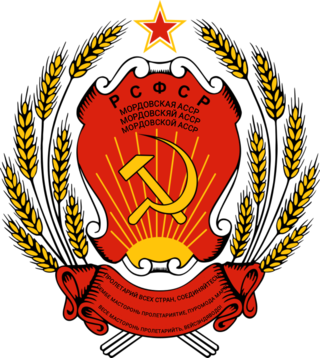
The national emblem of the Mordovian Autonomous Soviet Socialist Republic was adopted in 1937 by the government of the Mordovian Autonomous Soviet Socialist Republic. The emblem is identical to the emblem of the Russian Soviet Federative Socialist Republic.

The flag the Yakut Autonomous Soviet Socialist Republic was adopted in 1954 by the government of the Yakut Autonomous Soviet Socialist Republic. The flag is identical to the flag of the Russian Soviet Federative Socialist Republic.
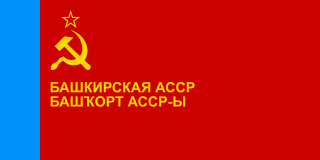
The flag of the Bashkir Autonomous Soviet Socialist Republic was adopted in 1954 by the government of the Bashkir Autonomous Soviet Socialist Republic. The flag is identical to the flag of the Russian Soviet Federative Socialist Republic.

The flag of the Komi Autonomous Soviet Socialist Republic was adopted in 1954 by the government of the Komi Autonomous Soviet Socialist Republic. The flag is identical to the flag of the Russian Soviet Federative Socialist Republic.

The flag of the North Ossetian Autonomous Soviet Socialist Republic was adopted in 1954 by the government of the North Ossetian Autonomous Soviet Socialist Republic. The flag is identical to the flag of the Russian Soviet Federative Socialist Republic.
































